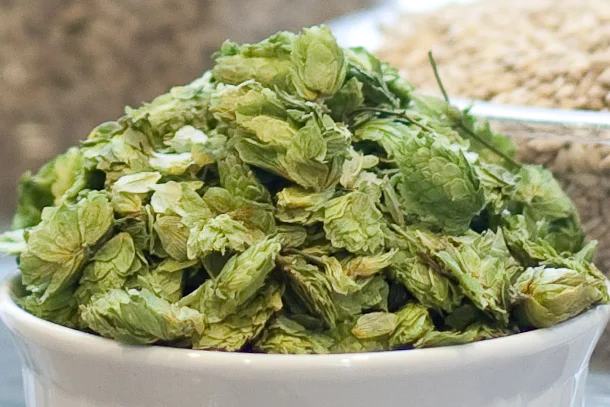What are the differences between pellet hops and whole leaf hops?
Pellet hops and whole leaf hops are two different forms of hops that are used in brewing beersies.
The main difference between the two is the way they are processed and packaged.
Pellet hops are made by taking whole leaf hops and compressing them into small, pellet-shaped pieces. The pellets are then packaged in airtight containers to preserve their freshness. Pellet hops are convenient to use in brewing because they are easy to measure and add to the boil on brewing day!
Pellet hops are made by taking whole leaf hops and compressing them into small, pellet-shaped pieces. The pellets are then packaged in airtight containers to preserve their freshness. Pellet hops are convenient to use in brewing because they are easy to measure and add to the boil on brewing day!
They also take up less space in storage than whole leaf hops.
Whole leaf hops, on the other hand, are simply the dried and packaged whole hop cones. They are not compressed, so they are larger and fluffier than pellet hops. Whole leaf hops are used less frequently than pellet hops in brewing because they are harder to measure and add to the boil, and they take up more space in storage.
In terms of brewing, pellet hops are known to be more efficient than whole leaf hops as they have a higher utilization rate, meaning that more of the alpha acids are extracted during the boiling process.
Whole leaf hops tend to give a more intense aroma and flavor, but also take more time to settle out of the beer and can cause more cloudiness.
If you didn't know, utilisation rates can be quite useful knowledge for super keen beer brewers.
The utilization rate of hops refers to the percentage of the alpha acid content in the hops that is converted into bittering compounds when added to the beer wort during the boiling process. This rate can be affected by a number of factors, including the length of the boil, the temperature of the wort, and the pH of the wort. A higher utilization rate results in a more bitter beer, while a lower utilization rate results in a less bitter beer.
The utilization rate of hops refers to the percentage of the alpha acid content in the hops that is converted into bittering compounds when added to the beer wort during the boiling process. This rate can be affected by a number of factors, including the length of the boil, the temperature of the wort, and the pH of the wort. A higher utilization rate results in a more bitter beer, while a lower utilization rate results in a less bitter beer.
What are cryo and powdered hops?
Powdered hops is a form of hops that have been ground into a fine powder, it is not as common as other forms of hops. Powdered hops can be used in the brewing process, but they can be difficult to measure accurately and may not be as efficient as pellet or leaf hops.
Cryo Hops, also known as cryogenic hops, is a process that uses liquid nitrogen to separate the lupulin gland from the leafy matter of the hop cone. This process results in a product that is more concentrated in resins and oils, and less in vegetal matter. Cryo hops are considered to be more efficient as they have a higher utilization rate, meaning that more of the alpha acids are extracted during the boiling process. They also tend to impart a more intense aroma and flavor to the beer.
Lupulin hops is a product that is made by separating the Lupulin gland, which contains the resins and oils that give hops their bittering and aroma properties, from the rest of the hop cone. Lupulin hops are considered to be more efficient as they have a higher utilization rate, meaning that more of the alpha acids are extracted during the boiling process. They also tend to impart a more intense aroma and flavor to the beer.
In terms of efficiency, Cryo Hops and Lupulin hops are considered to be more efficient than pellet or leaf hops as they have a higher utilization rate, meaning that more of the alpha acids are extracted during the boiling process. However, they are not as common and tend to be more expensive than other forms of hops.
Ultimately, the choice of which type of hops to use depends on the brewer's preference, brewing process and the desired outcome in terms of aroma, flavor, and efficiency.
Can whole leaf hops become infected?
Yes, whole leaf hops can indeed become infected with various types of bacteria and fungi.
These infections can occur during the growing process, during harvest, or during storage. Some common types of infections that can affect hops include:
- Downy mildew: A type of fungus that can cause yellow or brown spotting on the leaves and cones of the hop plant. It can also lead to reduced yields and reduced hop quality.
- Powdery mildew: Another type of fungus that can affect hop plants, causing a white or gray powdery coating on the leaves and cones. This can also lead to reduced yields and reduced hop quality.
- Bacterial diseases: Certain types of bacteria, such as Pseudomonas syringae, can infect hop plants and cause wilting, leaf spot, and cankers. This can lead to reduced yields and reduced hop quality.
- Storage mold: Hops that are stored in damp or humid conditions can develop mold growth, which can affect the quality and aroma of the hops.
If you suspect that your hops are infected, it's best to discard them and not use them for brewing. Using infected hops in brewing can lead to off flavors, aromas and even spoil the beer.
















0 comments:
Post a Comment